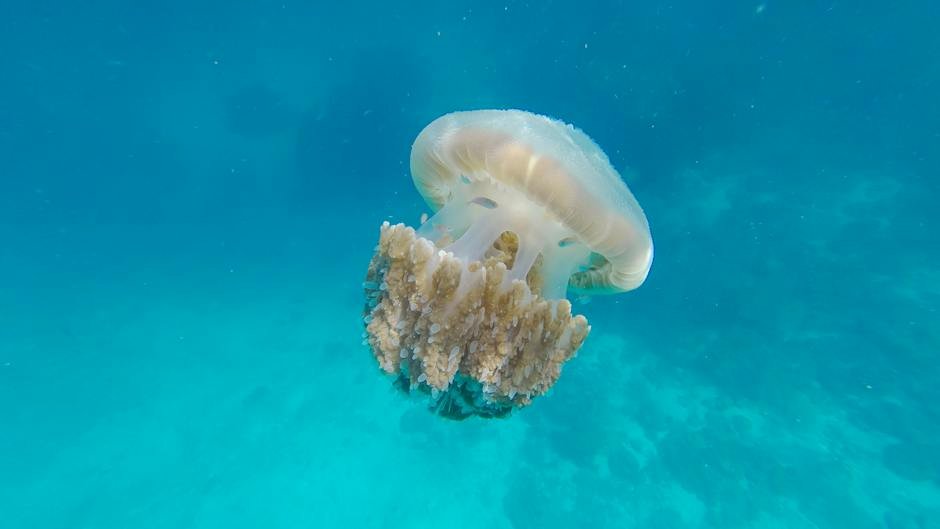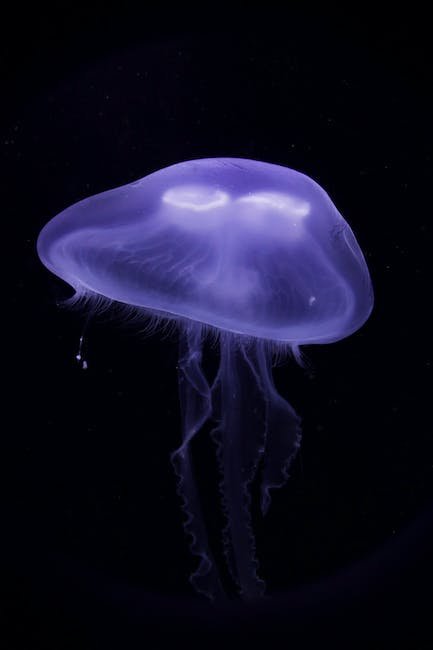Now Reading: How to Treat Jellyfish Stings in the Ocean
-
01
How to Treat Jellyfish Stings in the Ocean

How to Treat Jellyfish Stings in the Ocean
As the gentle waves caress the shore, and the golden sun illuminates the horizon, we find solace in the mesmerizing beauty of the ocean. But amidst its enchantment lies a hidden danger that can catch even the most seasoned swimmers off guard—the jellyfish sting. These ethereal creatures, drifting aimlessly in the vast blue expanse, possess tentacles adorned with venomous cells, capable of inflicting excruciating pain and discomfort. Fear not, for in this article, we shall embark on a journey to unravel the secrets of treating jellyfish stings, equipping you with the knowledge and remedies necessary to navigate the ocean’s wonderland safely and with confidence.
Table of Contents
- Treating Jellyfish Stings: A Comprehensive Guide to Ocean First Aid
- Understanding Jellyfish Stings: Identifying Common Symptoms and Reactions
- Immediate Actions: Steps to Take When Stung by a Jellyfish in the Ocean
- Effective Remedies: Natural and Medical Treatments for Jellyfish Stings
- Prevention and Safety Measures: Tips to Avoid Jellyfish Stings in the Future
- Q&A
- The Way Forward

Treating Jellyfish Stings: A Comprehensive Guide to Ocean First Aid
Treating Jellyfish Stings
Encountering jellyfish while swimming or diving can be a painful experience, but with the right knowledge of ocean first aid, you can minimize discomfort and promote healing. Follow these steps to effectively treat jellyfish stings:
- Assess the situation: Before providing any treatment, ensure the safety of yourself and others in the vicinity. If the sting occurred in shallow water, carefully move the patient to dry land.
- Remove any tentacles: Using a pair of tweezers or gloves, gently pick off any visible jellyfish tentacles from the skin. Avoid using bare hands to prevent further exposure or injury.
- Rinse the affected area: Clean the wound with seawater, not fresh water, to avoid triggering more venom release. Be cautious not to rub or scrub the injury, as it may cause the venom to spread.
- Apply a vinegar solution: To neutralize any remaining venom, pour or spray vinegar solution directly over the affected area for about 30 seconds. This helps alleviate pain and reduce further irritation.
- Immerse in hot water: Soaking the affected area in hot water (around 45-50°C or 113-122°F) for 20-45 minutes can provide relief by inactivating the stinging cells’ venom. Regularly check the water temperature to ensure it remains within a tolerable range.
- Administer pain relief: Over-the-counter pain relievers, such as ibuprofen or acetaminophen, can help manage any lingering discomfort. Always follow the recommended dosage instructions.
- Monitor for severe reactions: While most jellyfish stings cause mild symptoms, such as redness and swelling, some individuals may experience allergic reactions or more serious complications. If the patient develops difficulty breathing, chest pain, or signs of anaphylactic shock, seek immediate medical attention.
Remember, prevention is the best defense against jellyfish stings. By wearing a stinger suit or protective clothing, using repellents, and staying informed about local marine hazards, you can greatly reduce the risk of encounters and enjoy your time in the ocean safely.

Understanding Jellyfish Stings: Identifying Common Symptoms and Reactions
When it comes to jellyfish stings, being able to identify the common symptoms and reactions is crucial. Understanding what you’re dealing with can help you respond appropriately and seek the necessary medical attention if needed.
Physical symptoms:
- Localized pain and redness: One of the most immediate symptoms of a jellyfish sting is the sharp pain and redness that occurs at the site of contact with the tentacles.
- Swelling and welts: The affected area may become swollen and develop raised, itchy welts.
- Blisters and ulcerations: In some cases, blisters or ulcerations may form on the skin, particularly if the sting is severe.
Systemic reactions:
- Itching and rash: You may experience a general itching sensation and notice a rash spreading beyond the area of the sting.
- Nausea and vomiting: In more severe cases, jellyfish stings can cause gastrointestinal symptoms such as nausea and vomiting.
- Difficulty breathing: Rarely, individuals may experience shortness of breath or difficulty breathing, which should be treated as a medical emergency.
Note: It is important to remember that the severity of jellyfish stings can vary greatly depending on the type of jellyfish, the individual’s sensitivity, and other factors. If you or someone else has been stung, always consult a healthcare professional for proper evaluation and treatment.

Immediate Actions: Steps to Take When Stung by a Jellyfish in the Ocean
Encountering a jellyfish sting while enjoying a swim in the ocean can be quite unpleasant, but fear not! Swiftly attending to the situation can alleviate discomfort and ensure a speedy recovery. Here’s a list of proactive measures you can take when stung by a jellyfish:
- Get out of the water: As soon as you notice the sting, it’s crucial to remove yourself from the ocean. Avoid further contact with any marine creatures to prevent additional injuries or stings.
- Look for tentacles: Inspect the affected area for any remaining jellyfish tentacles attached to your skin. Be careful not to touch them with bare hands – use a pair of tweezers, gloves, or even a plastic card to gently remove them, as some species may continue to release venom even after being detached.
- Rinse with seawater: Rather counterintuitively, rinsing the affected area with seawater can help remove any remaining tentacles, venom, or tiny nematocysts that may have discharged during the sting. Do not use freshwater, as it may trigger more nematocysts to fire, increasing the pain.
- Apply vinegar solution: Once you’ve rinsed the area thoroughly, apply a vinegar solution (mixing 1 part vinegar with 3 parts seawater) to neutralize any remaining stinging cells. This can help alleviate pain and prevent the venom from spreading further.
- Immerse in hot water: To further lessen the pain and neutralize toxins, immerse the affected area in hot water. The heat will prompt the blood vessels to expand, assisting in the breakdown of venom proteins. Maintain the water temperature at a tolerable level.
- Seek medical attention: If the pain persists, the sting covers a large area of your body, or you experience difficulty breathing, dizziness, or other severe symptoms, it is essential to seek immediate medical assistance. A medical professional can provide additional treatment and ensure your well-being.
Remember, every jellyfish sting is unique, and reactions may vary from person to person. While these immediate actions can be helpful for most jellyfish stings, it’s always advisable to consult with medical experts or lifeguards in your area for more comprehensive guidance.

Effective Remedies: Natural and Medical Treatments for Jellyfish Stings
Dealing with a jellyfish sting can be painful and unsettling, but fear not! Whether you prefer natural or medical treatments, there are numerous remedies available to alleviate the discomfort and promote healing.
1. Natural Remedies
Mother Nature has provided us with an array of soothing options to ease the sting. Here are some natural remedies that you can try:
- Vinegar: Immediately rinse the affected area with vinegar to neutralize the venom and prevent further release.
- Hot water: Soaking the sting in hot water (not scalding) can help relieve pain and reduce swelling by breaking down the venom’s proteins.
- Aloe vera: Apply a generous amount of aloe vera gel to the sting to soothe the skin and provide additional relief.
- Activated charcoal paste: Mix activated charcoal powder with water to create a paste and apply it to the sting. This can help draw out toxins and reduce swelling.
2. Medical Treatments
If natural remedies don’t suffice or the reaction is severe, medical treatments may be necessary. Seek professional help if the following symptoms occur:
- Difficulty breathing
- Chest pain
- Faintness
- Swelling around the lips or tongue
- Multiple stings
Medical treatments for jellyfish stings may include antihistamines, pain relievers, topical steroids, and in severe cases, the administration of antivenom. It is crucial to consult a healthcare professional for an accurate diagnosis and appropriate treatment.
Prevention and Safety Measures: Tips to Avoid Jellyfish Stings in the Future
When it comes to enjoying a day at the beach or a swim in the ocean, the last thing anyone wants is a painful jellyfish sting. Thankfully, there are several practical measures you can take to minimize the chances of encountering these gelatinous creatures. Follow these tips to stay jellyfish sting-free on your next beach visit:
- Research the area: Before heading to a beach, it’s wise to do a little research on whether jellyfish are often spotted in the waters. Knowing the prevalence of jellyfish in a specific area can help you decide whether it’s safe to swim or if you should seek an alternative location.
- Wear protective clothing: Covering your body with a rash guard or wetsuit can act as a barrier between your skin and any lurking jellyfish. Remember to opt for light-colored clothing as some jellyfish are attracted to dark shades.
- Stay alert: While swimming, keep a close eye out for any jellyfish in the water. Jellyfish can be transparent and easily go unnoticed. If you spot one, carefully move away and give it a wide berth.
- Apply vinegar: Should you come into contact with a jellyfish tentacle, immediately rinse the affected area with vinegar. The acidity of the vinegar helps neutralize the venom and alleviate pain. It’s always a good idea to carry a small bottle of vinegar with you when visiting the beach.
- Follow local advice: If there are warning signs or lifeguards informing beachgoers of jellyfish presence, adhere to their instructions promptly. They have invaluable knowledge of the area and can provide guidance on how to swim safely in jellyfish-infested waters.
By taking these measures, you can enjoy the beach without worrying about pesky jellyfish stings. Remember, prevention is key, and being prepared will ensure a safe and enjoyable aquatic experience for everyone.
Q&A
How do jellyfish stings occur?
Jellyfish stings occur when a person inadvertently comes into contact with the tentacles of a jellyfish. The tentacles release venomous cells called nematocysts, which inject venom into the victim’s skin.
What are the symptoms of a jellyfish sting?
The symptoms of a jellyfish sting include pain, redness, swelling, itching, and in some cases, an allergic reaction. In severe cases, individuals may experience difficulty breathing and muscle cramps.
What should I do if I get stung by a jellyfish?
If you get stung by a jellyfish, first and foremost, calmly and swiftly exit the water to prevent further stings. Rinse the affected area with seawater, not fresh water, to avoid triggering additional venom release. Remove any visible tentacles with tweezers or a gloved hand and apply vinegar to the area to neutralize the venom.
Can I use urine to treat a jellyfish sting?
Contrary to popular belief, using urine to treat a jellyfish sting is not recommended. It does not deactivate the venom and can actually worsen the sting by causing more nematocysts to release venom. Stick to using vinegar or hot water instead.
Should I scrub the wound after a jellyfish sting?
No, you should never scrub the wound after a jellyfish sting. Rubbing or scrubbing the area may trigger the release of more venom. Instead, carefully rinse the affected area with saltwater and gently remove any tentacles using tweezers or a similar tool.
When should I seek medical help for a jellyfish sting?
It is advisable to seek medical help for a jellyfish sting if the symptoms are severe, if the individual is experiencing difficulty breathing, or if they have been stung by a particularly dangerous species such as a box jellyfish. Foreign beaches may also have different species, so consulting a local expert can be beneficial.
What are some ways to prevent jellyfish stings?
To prevent jellyfish stings, it is recommended to swim in patrolled beaches where lifeguards can provide advice and information. Additionally, wearing protective clothing like rash guards or full-body swimsuits, avoiding swimming during jellyfish season, and steering clear of jellyfish-affected areas can significantly reduce the risk of stings.
The Way Forward
As you bid adieu to the enchanting world of the ocean, armed with newfound knowledge on treating jellyfish stings, it’s crucial to remember the symbiotic dance we share with this magnificent realm. While these ethereal creatures can give an unexpected sting, our understanding and respect for their habitat empowers us to navigate these waters with confidence. By following the steps outlined in this guide, you have equipped yourself with the tools to swiftly address jellyfish stings, turning potential discomfort into a mere ripple in your aquatic adventures. So, dive in fearlessly, knowing you hold the transformative power to turn stinging encounters into remarkable tales of sea-bound triumph. With every encounter, let curiosity lead the way, fostering a deeper connection to the mesmerizing mysteries that lie beneath. Soak in the salty breeze, relish the golden embrace of sunlight, and savor each fleeting moment in this awe-inspiring environment. Remember, while jellyfish may sting, they are but ephemeral threads in the grand tapestry of the ocean’s wonders. So, venture forth, explorers of the deep, and let the rhythm of the waves guide your spirited journey.
As an affiliate, my content may feature links to products I personally use and recommend. By taking action, like subscribing or making a purchase, you’ll be supporting my work and fueling my taco cravings at the same time. Win-win, right?
Want to read more? Check out our Affiliate Disclosure page.





